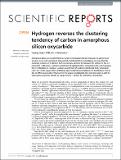Hydrogen reverses the clustering tendency of carbon in amorphous silicon oxycarbide
Author(s)
Ding, Hepeng; Demkowicz, Michael J.
DownloadDing_Hydrogen reverses.pdf (1.202Mb)
PUBLISHER_CC
Publisher with Creative Commons License
Creative Commons Attribution
Terms of use
Metadata
Show full item recordAbstract
Amorphous silicon oxycarbide (SiOC) is of great technological interest. However, its atomic-level structure is not well understood. Using density functional theory calculations, we show that the clustering tendency of C atoms in SiOC is extremely sensitive to hydrogen (H): without H, the C-C interaction is attractive, leading to enrichment of aggregated SiC[subscript 4] tetrahedral units; with hydrogen, the C-C interaction is repulsive, leading to enrichment of randomly distributed SiCO[subscript 3] tetrahedral units. Our results suggest that conflicting experimental characterizations of C distributions may be due to differing amounts of H present in the samples investigated. Our work also opens a path for tailoring the properties of SiOC by using the total H content to control the C distribution.
Date issued
2015-08Department
Massachusetts Institute of Technology. Department of Materials Science and EngineeringJournal
Scientific Reports
Publisher
Nature Publishing Group
Citation
Ding, Hepeng, and Michael J. Demkowicz. “Hydrogen Reverses the Clustering Tendency of Carbon in Amorphous Silicon Oxycarbide.” Scientific Reports 5 (August 13, 2015): 13051.
Version: Final published version
ISSN
2045-2322